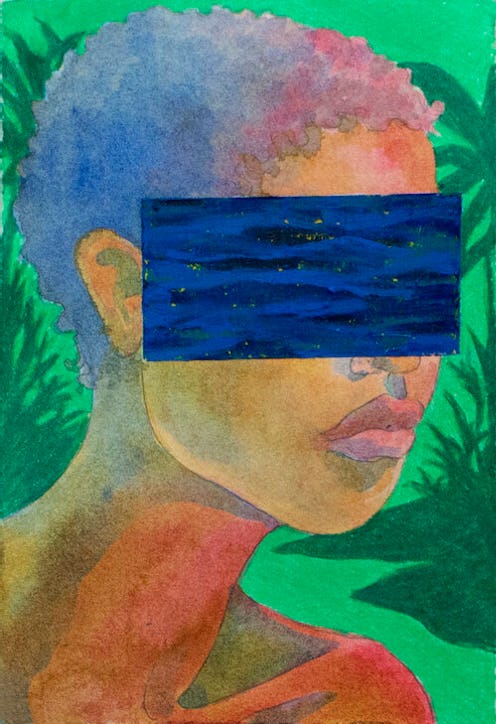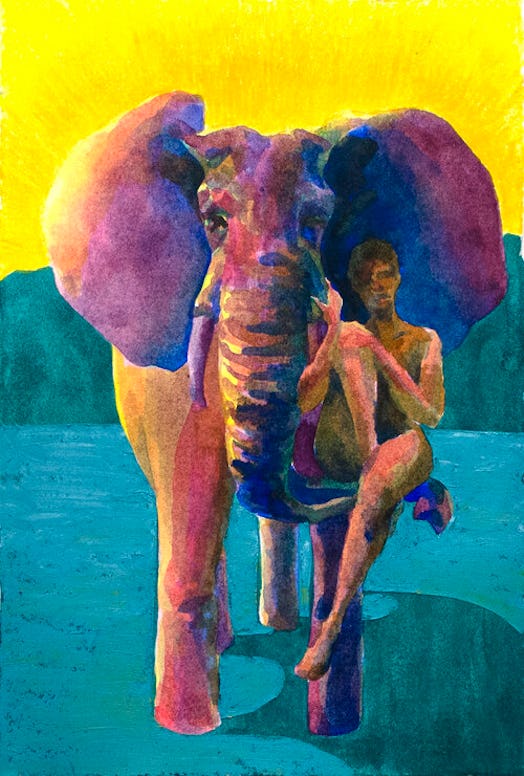But all that changed in mid-2020 amidBlack Lives Matters protestsand the ongoing pandemic.
It felt like a necessary investigation for myself, and a necessary conversation for me to have.
Soon after,Manifesting Paradise a hopeful, tarot-inspired project that looks to the future was born.

The artwork is currently on display at an exhibition in theAcademy Art Museumin Easton, Maryland until July 24.
But Tarvers not done with tarot just yet.
I’m going to keep going until I completeall 78 cards, Tarver says.

There will be a full deck.
Below, Tarver shares three pieces from the project that hold special meaning.
High Priestess
This was one of the earliest ones.

I think [High Priestess] really embodied that feeling for me.
When people see High Priestess, I hope that there’s a sense of calm.
There’s water over her eyes, and hearing people’s interpretation of it is pretty spot on.

There’s this understanding that she’s not blind, somehow she’s still knowledgeable.
I wouldn’t say shes all-knowing necessarily, but she’s still knowledgeable.
She’s still in touch, even without her sight.
It’s kind of like the cliche, don’t believe everything you see.
But I love elephants I think they’re incredible animals.
They’re super intelligent and emotional.
They run like matriarchal groups.
There’s this whole female-centered system that’s natural to how they structure themselves.
So there’s this gentle strength because theyre actually very sensitive animals, along with their physical presence.
Because of this fascination with them when I was younger, I made this painting.
I recognized how it suited the card and this idea of strength so well.
The interpretation of Strength, for me, is not about physical strength.
It’s about sustaining strength over a period.
It’s about the intelligence, the emotional intelligence, thats needed to persevere in life.
I’ve never seen a tarot reader be able to give it a great spin.
It’s about destruction and necessary upheaval, and usually, its one thats a surprise.
Traditionally, its [symbol] is a medieval tower that’s struck by lightning.
The tower’s on fire, and people are jumping out of it.
I was really struggling to figure out how to interpret it for myself.
You don’t really want to think about the possibility of surprise destruction in your own life.
I had found images of the former Tarver Plantation that still stands.
This was the same time as protests were happening during the pandemic.
Understanding what that meant there felt palpable.
I see how it can be maybe not positive but necessary.
Working on this felt a little cathartic.
But also, I was kind of scared.
It sounds silly because I wasn’t actually burning down a house.
It was just in concept.
But I think this system is so ingrained in who we are as a country.
Theyve been repurposed and their narrative has changed.
Theyve kind of gotten a PR bump.
I lived in Georgia for seven years as a kid.
These landscapes and things like plantation houses are ingrained in my memory in a positive way.
I see the beauty of these places, so it’s complicated in my memory.
It almost felt like a betrayal [to make].
This is actually the thing that’s destructive and destroying it is what allows you to move on.
This interview has been edited and condensed for clarity.